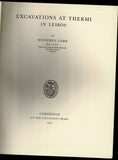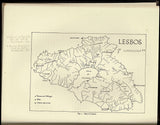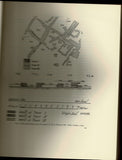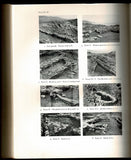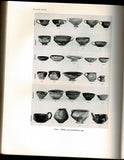Excavations at Thermi in Lesbos
Author: Winifred Lamb (1894-1963)
Year: 1936
Publisher: Cambridge University Press
Place: Cambridge
Description:
xii+226+[blank]+[50 plates] with diagrams, map, illustrations, appendix and index. Folio (12" x 9 1/2") bound in original publisher's brown cloth with gilt lettering to spine. First edition.
This book contains a record of excavations at Thermi on the Greek island of Lesbos, led by renowned British archaeologist Winifred Lamb over a period of several years in the late 1920s and early 1930s. The text is well supplied with drawings and plates of the various buildings and artefacts uncovered during the excavation, the majority of which are from the Bronze Age. This book will be of value to anyone with an interest in Lamb's work, ancient history or Bronze Age Greece.
The prehistoric settlement of Thermi on Lesbos provides one of the earliest examples of urbanization in the Mediterranean, with urban features and town planning from the beginning of the 3rd millennium BC. With five main building phases of the Early Bronze Age, as well as Middle and Late Bronze Age levels, the town – on a sea route which joined the north and south Aegean and the West with the East – is part of a broad cultural horizon which includes the Balkans and Troy to the north, extending to Cyprus in south. There are contacts too with the Cyclades and Mainland Greece. Thermi was identified and excavated by Winifred Lamb between 1930 and 1933: her exemplary report was published in 1936. Lamb had back-filled all the trenches to protect the remains and the site remained invisible and inaccessible until 2005 when, on the initiative of the 20th Ephorate of Prehistoric and Classical Antiquities the refurbishment and presentation of Thermi was incorporated in the 2000-2006 Regional Operational Programme for the North Aegean. The work of uncovering and laying out the site was completed in 2008; supplementary trenches were excavated in 2011. The Ephorate’s work brought to light new evidence for the life of the settlement, not only in the Early Bronze Age but also during the period of its reoccupation in the Middle and Late Bronze Age.
Condition:
Previous owner's name to front paste down, some occasional pencil marginalia, corners gently bumped, some light soiling to page ends else very good.










